Website basquiat.com Name Jean-Michel Basquiat | Role Artist Fields Painting, Musician | |
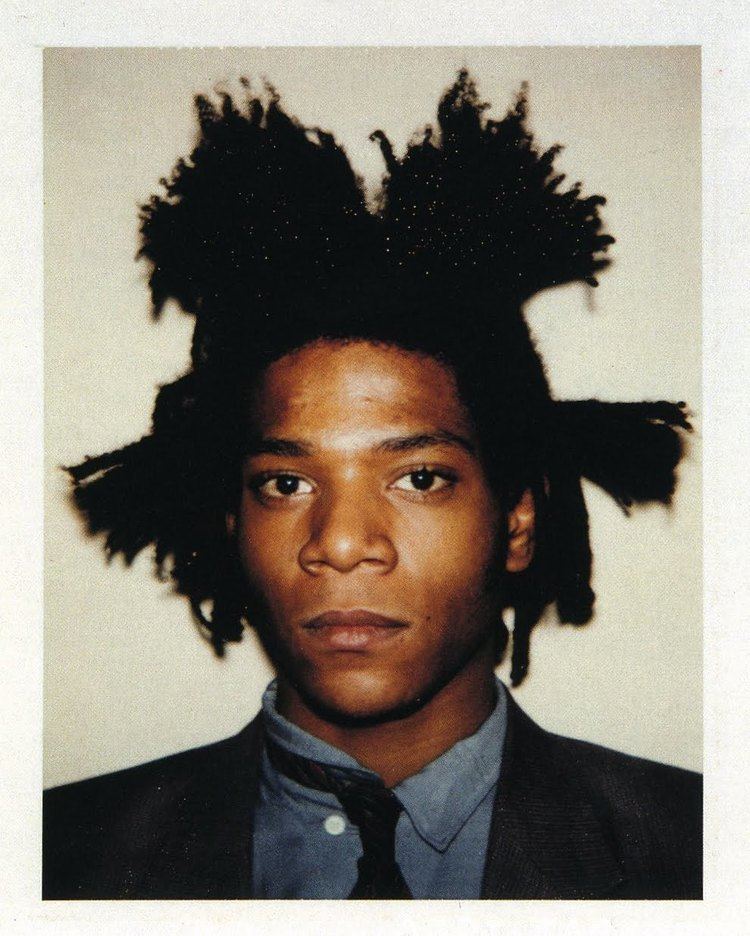 | ||
Style Abstraction, figuration Influenced by Parents Matilda Andrades, Gerard Basquiat Artwork Irony of Negro Policeman, Untitled (1981), Hollywood Africans, Untitled (Boxer), In Italian Similar People Andy Warhol, Keith Haring, Pablo Picasso, Roy Lichtenstein, Jeff Koons | ||
Fabolous reveals his artist past on tour of jean michel basquiat exhibit
Jean-Michel Basquiat ([ʒɑ̃ miʃɛl baskija]; December 22, 1960 – August 12, 1988) was an American artist. Basquiat first achieved fame as part of SAMO©, an informal graffiti duo who wrote enigmatic epigrams in the cultural hotbed of the Lower East Side of Manhattan during the late 1970s where the hip hop, post-punk, and street art movements had coalesced. By the 1980s, he was exhibiting his neo-expressionist paintings in galleries and museums internationally. The Whitney Museum of American Art held a retrospective of his art in 1992.
Contents
- Fabolous reveals his artist past on tour of jean michel basquiat exhibit
- Video jean michel basquiat part 1
- Early life
- Career
- Artistic styles
- Heritage depicted in art
- Exhibitions
- Final years and death
- Legacy
- In literature
- In film
- In music
- Collections
- Art market
- Authentication Committee
- References
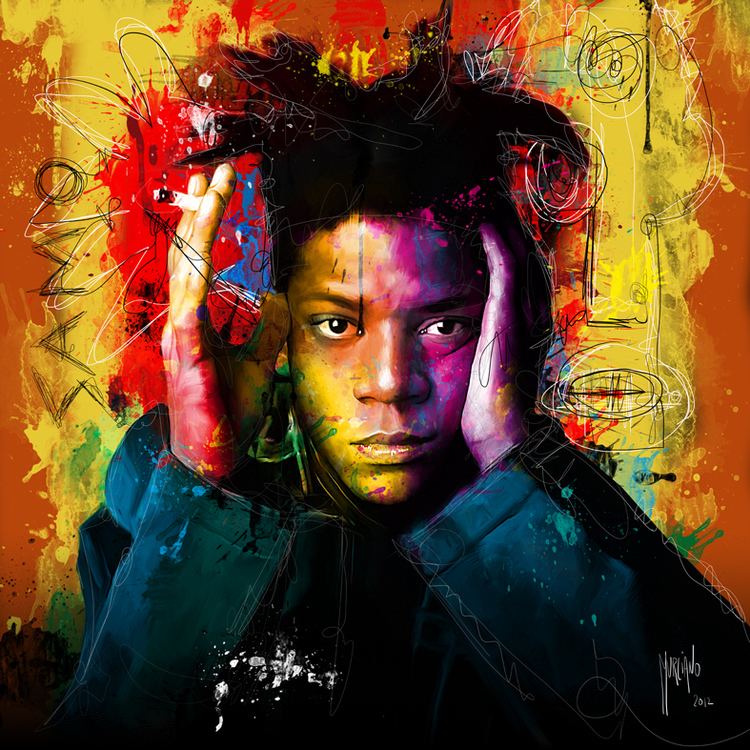
Basquiat's art focused on "suggestive dichotomies", such as wealth versus poverty, integration versus segregation, and inner versus outer experience. He appropriated poetry, drawing, and painting, and married text and image, abstraction, figuration, and historical information mixed with contemporary critique.
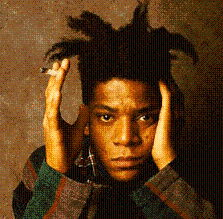
Basquiat used social commentary in his paintings as a "springboard to deeper truths about the individual", as well as attacks on power structures and systems of racism, while his poetics were acutely political and direct in their criticism of colonialism and support for class struggle. He died of a heroin overdose at his art studio at age 27.
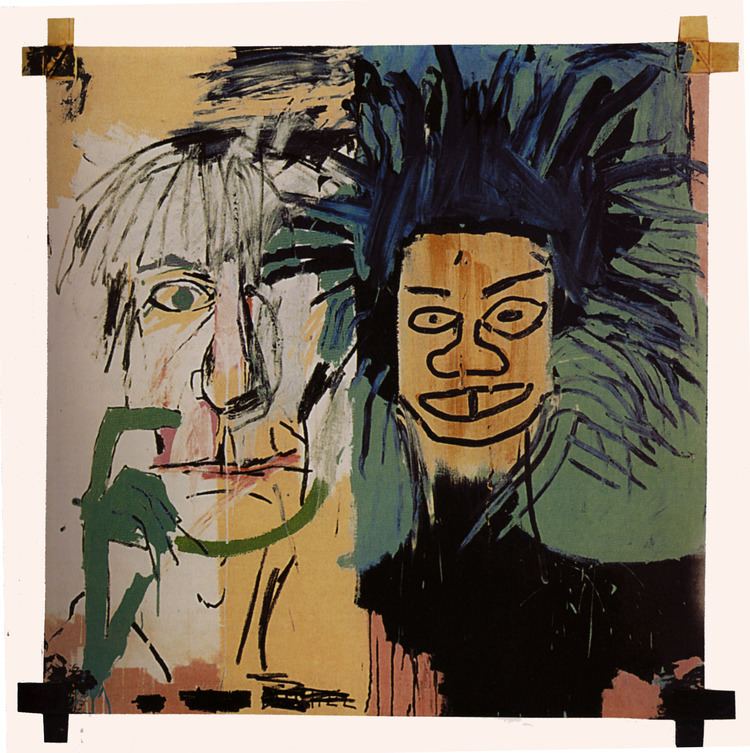
On May 18, 2017, at a Sotheby's auction, Basquiat's 1982 painting, also Untitled, created with oil stick and spray paint and depicting a skull, set a new record high for any U.S. artist at auction, selling for $110,500,000.
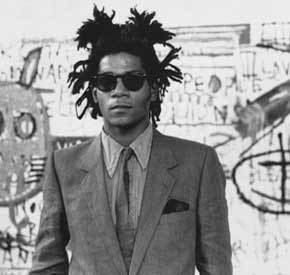
Video jean michel basquiat part 1
Early life
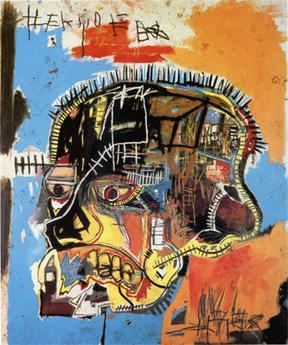
Jean-Michel Basquiat was born in Brooklyn, New York, on December 22, 1960, shortly after the death of his elder brother, Max. He was the second of four children of Matilda Andrades (July 28, 1934 – November 17, 2008) and Gérard Basquiat (1930 – July 7, 2013). He had two younger sisters: Lisane, born in 1964, and Jeanine, born in 1967.
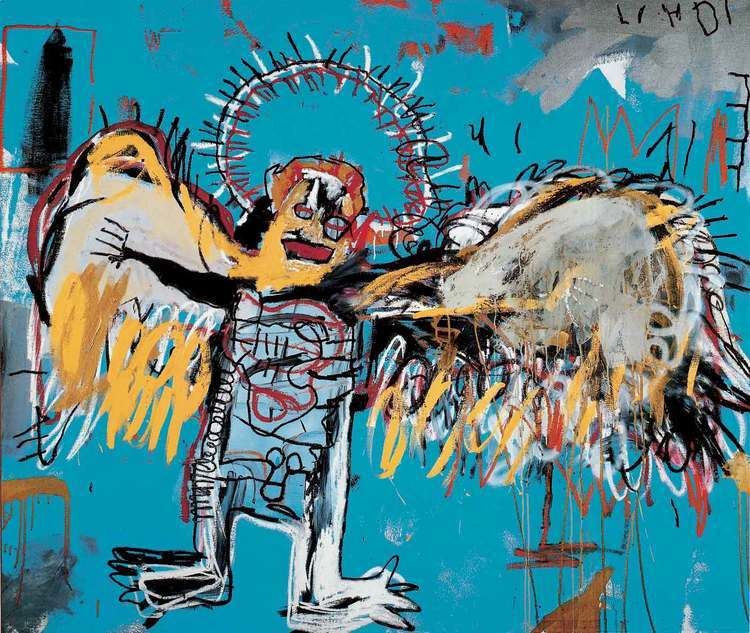
His father, Gérard Basquiat, was born in Port-au-Prince, Haiti, and his mother, Matilde Basquiat, who was of Puerto Rican descent, was born in Brooklyn, New York. Matilde instilled a love for art in her young son by taking him to art museums in Manhattan and enrolling him as a junior member of the Brooklyn Museum of Art. Basquiat was a precocious child who learned how to read and write by age four and was a gifted artist. His teachers, such as artist Jose Machado, noticed his artistic abilities, and his mother encouraged her son's artistic talent. By the age of 11, Basquiat was fully fluent in French, Spanish and English. In 1967, Basquiat started attending Saint Ann's, an arts-oriented exclusive private school. He drew with Marc Prozzo, a friend from St. Ann's; they together created a children's book, written by Basquiat and illustrated by Prozzo. Basquiat became an avid reader of Spanish, French, and English texts and a more than competent athlete, competing in track events.

In September 1968, when Basquiat was about eight, he was hit by a car while playing in the street. His arm was broken and he suffered several internal injuries, and he eventually underwent a splenectomy. While he was recuperating from his injuries, his mother brought him the Gray's Anatomy book to keep him occupied. This book would prove to be influential in his future artistic outlook. His parents separated that year and he and his sisters were raised by their father. The family resided in Boerum Hill, Brooklyn, for five years, then moved to San Juan, Puerto Rico in 1974. After two years, they returned to New York City.
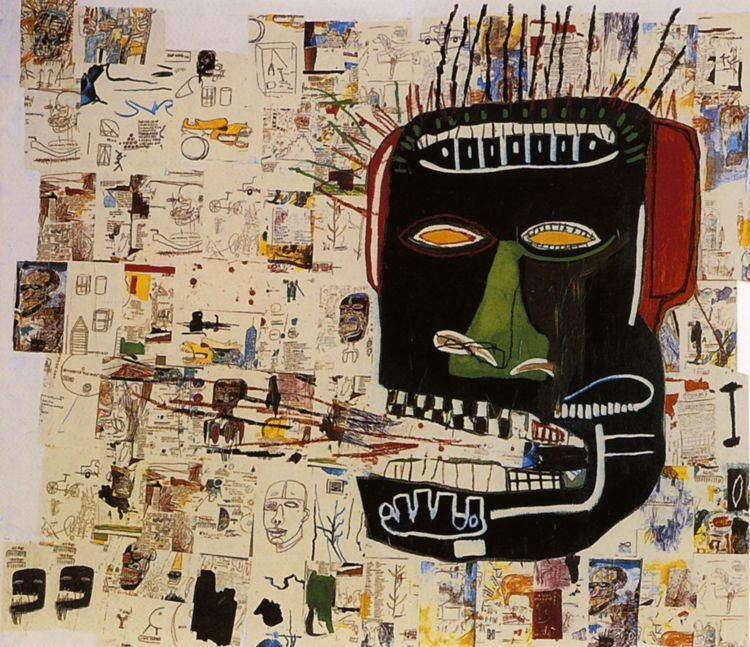
When he was 13, his mother was committed to a mental institution and thereafter spent time in and out of institutions. At 15, Basquiat ran away from home. He slept on park benches in Tompkins Square Park, and was arrested and returned to the care of his father within a week.
Basquiat dropped out of Edward R. Murrow High School in the tenth grade and then attended City-As-School, an alternative high school in Manhattan home to many artistic students who failed at conventional schooling. His father banished him from the household for dropping out of high school and Basquiat stayed with friends in Brooklyn. He supported himself by selling T-shirts and homemade post cards.
Career
Basquiat went from being homeless and unemployed to selling a single painting for up to $25,000 in a matter of several years.
In 1976, Basquiat and friend Al Diaz began spray painting graffiti on buildings in Lower Manhattan, working under the pseudonym SAMO. The designs featured inscribed messages such as "Plush safe he think.. SAMO" and "SAMO as an escape clause". In 1978, Basquiat worked for the Unique Clothing Warehouse in their art department at 718 Broadway in NoHo and at night he began "SAMO" painting his original graffiti art on neighborhood buildings. Unique's founder Harvey Russack discovered Basquiat painting a building one night, they became friends, and he offered him a day job. On December 11, 1978, The Village Voice published an article about the graffiti. When Basquiat and Diaz ended their friendship, The SAMO project ended with the epitaph "SAMO IS DEAD", inscribed on the walls of SoHo buildings in 1979.
In 1979, Basquiat appeared on the live public-access television show TV Party hosted by Glenn O'Brien, and the two started a friendship. Basquiat made regular appearances on the show over the next few years. That same year, Basquiat formed the noise rock band Test Pattern – which was later renamed Gray – which played at Arleen Schloss's open space, "Wednesdays at A's", where in October 1979 Basquiat showed, among others, his SAMO color Xerox work.
Gray also consisted of Shannon Dawson, Michael Holman, Nick Taylor, Wayne Clifford and Vincent Gallo, and the band performed at nightclubs such as Max's Kansas City, CBGB, Hurrah and the Mudd Club. In 1980, Basquiat starred in O'Brien's independent film Downtown 81, originally titled New York Beat. That same year, Basquiat met Andy Warhol at a restaurant. Basquiat presented to Warhol samples of his work, and Warhol was stunned by Basquiat's genius and allure. The two artists later collaborated. Downtown 81 featured some of Gray's recordings on its soundtrack. Basquiat also appeared in the 1981 Blondie music video "Rapture," in a role originally intended for Grandmaster Flash, as a nightclub disc jockey.
The early 1980s were Basquiat's breakthrough as a solo artist. In June 1980, Basquiat participated in The Times Square Show, a multi-artist exhibition sponsored by Collaborative Projects Incorporated (Colab) and Fashion Moda. In September of the same year, Basquiat joined the Annina Nosei gallery and worked in a basement below the gallery toward his first one-man show, which took place in March 1981 with great success. In December 1981, René Ricard published "The Radiant Child" in Artforum magazine, which brought Basquiat to the attention of the art world.
In March 1982 he worked in Modena, Italy, and from November, Basquiat worked from the ground-floor display and studio space Larry Gagosian had built below his Venice, California, home and commenced a series of paintings for a 1983 show, his second at Gagosian Gallery, then in West Hollywood. He brought along his girlfriend, then unknown aspiring singer Madonna. During this time he took considerable interest in the work that Robert Rauschenberg was producing at Gemini G.E.L. in West Hollywood, visiting him on several occasions and finding inspiration in the accomplishments of the painter. In 1982, Basquiat worked briefly with musician and artist David Bowie.
In 1983, Basquiat produced a 12" rap single featuring hip-hop artists Rammellzee and K-Rob. Billed as Rammellzee vs. K-Rob, the single contained two versions of the same track: "Beat Bop" on side one with vocals and "Beat Bop" on side two as an instrumental. The single was pressed in limited quantities on the one-off Tartown Record Company label. The single's cover featured Basquiat's artwork, making the pressing highly desirable among both record and art collectors.
At the suggestion of Swiss dealer Bruno Bischofberger, Warhol and Basquiat worked on a series of collaborative paintings between 1983 and 1985. In the case of Olympic Rings (1985), Warhol made several variations of the Olympic five-ring symbol, rendered in the original primary colors. Basquiat responded to the abstract, stylized logos with his oppositional graffiti style.
Basquiat often painted in expensive Armani suits and would even appear in public in the same paint-splattered clothes.
Artistic styles
"Basquiat's canon revolves around single heroic figures: athletes, prophets, warriors, cops, musicians, kings and the artist himself. In these images the head is often a central focus, topped by crowns, hats, and halos. In this way the intellect is emphasized, lifted up to notice, privileged over the body and the physicality of these figures (i.e. black men) commonly represent in the world."
Fred Hoffman hypothesizes that underlying Basquiat's sense of himself as an artist was his "innate capacity to function as something like an oracle, distilling his perceptions of the outside world down to their essence and, in turn, projecting them outward through his creative acts." Additionally, continuing his activities as a graffiti artist, Basquiat often incorporated words into his paintings. Before his career as a painter began, he produced punk-inspired postcards for sale on the street, and became known for the political–poetical graffiti under the name of SAMO. On one occasion Basquiat painted his girlfriend's dress with the words "Little Shit Brown". He would often draw on random objects and surfaces, including other people's property. The conjunction of various media is an integral element of Basquiat's art. His paintings are typically covered with text and codes of all kinds: words, letters, numerals, pictograms, logos, map symbols, diagrams and more.
A middle period from late 1982 to 1985 featured multi-panel paintings and individual canvases with exposed stretcher bars, the surface dense with writing, collage and imagery. The years 1984–85 were also the main period of the Basquiat–Warhol collaborations, even if, in general, they were not very well received by the critics.
A major reference source used by Basquiat throughout his career was the book Gray's Anatomy, which his mother had given him while he was in the hospital at age seven. It remained influential in his depictions of internal human anatomy, and in its mixture of image and text. Other major sources were Henry Dreyfuss' Symbol Sourcebook, Leonardo da Vinci's notebooks, and Brentjes' African Rock Art.
Basquiat doodled often and some of his later pieces exhibited this; they were often colored pencil on paper with a loose, spontaneous, and dirty style much like his paintings. His work across all mediums displays a childlike fascination with the process of creating.
Heritage depicted in art
According to Andrea Frohne, Basquiat's 1983 painting Untitled (History of the Black People) "reclaims Egyptians as African and subverts the concept of ancient Egypt as the cradle of Western Civilization". At the center of the painting, Basquiat depicts an Egyptian boat being guided down the Nile River by Osiris, the Egyptian god of the earth and vegetation.
On the right panel of the painting appear the words "Esclave, Slave, Esclave". Two letters of the word "Nile" are crossed out and Frohne suggests that, "The letters that are wiped out and scribbled over perhaps reflect the acts of historians who have conveniently forgotten that Egyptians were black and blacks were enslaved." On the left panel of the painting Basquiat has illustrated two Nubian-style masks. The Nubians historically were darker in skin color, and were considered to be slaves by the Egyptian people.
Throughout the rest of the painting, images of the Atlantic slave trade are juxtaposed with images of the Egyptian slave trade centuries before. The sickle in the center panel is a direct reference to the slave trade in the United States, and slave labor under the plantation system. The word "salt" that appears on the right panel of the work refers to the Atlantic slave trade, as salt was another important commodity traded at that time.
Another of Basquiat's pieces, Irony of Negro Policeman (1981), is intended to illustrate how he believes African-Americans have been controlled by a predominantly Caucasian society. Basquiat sought to portray that African-Americans have become complicit with the "institutionalized forms of whiteness and corrupt white regimes of power" years after the Jim Crow era had ended. Basquiat found the concept of a "Negro policeman" utterly ironic. According to him the policeman should sympathize with his black friends, family, and ancestors, yet instead he was there to enforce the rules designed by "white society." The Negro policeman had "black skin but wore a white mask". In the painting, Basquiat depicted the policeman as large in order to suggest an "excessive and totalizing power", but made the policeman's body fragmented and broken.
The hat that frames the head of the Negro policeman resembles a cage, and represents what Basquiat believes are the constrained independent perceptions of African-Americans at the time, and how constrained the policeman's own perceptions were within white society. Basquiat drew upon his Haitian heritage by painting a hat that resembles the top hat associated with the gede family of loa, who embody the powers of death in Vodou.
However, Kellie Jones, in her essay Lost in Translation: Jean-Michel in the (Re)Mix, posits that Basquiat's "mischievous, complex, and neologistic side, with regard to the fashioning of modernity and the influence and effluence of black culture" are often elided by critics and viewers, and thus "lost in translation."
The art historian Olivier Berggruen situates in Basquiat's anatomical screen prints, titled Anatomy, an assertion of vulnerability, one which "creates an aesthetic of the body as damaged, scarred, fragmented, incomplete, or torn apart, once the organic whole has disappeared. Paradoxically, it is the very act of creating these representations that conjures a positive corporeal valence between the artist and his sense of self or identity."
Exhibitions
Basquiat's first public exhibition was in the group effort The Times Square Show (with David Hammons, Jenny Holzer, Lee Quiñones, Kenny Scharf and Kiki Smith among others), held in a vacant building at 41st Street and Seventh Avenue, New York. In late 1981, Basquiat joined the Annina Nosei gallery in SoHo; his first one-person exhibition was in 1982 at that gallery. By then, he was showing regularly alongside other Neo-expressionist artists including Julian Schnabel, David Salle, Francesco Clemente and Enzo Cucchi. He was represented in Los Angeles by the Gagosian gallery and throughout Europe by Bruno Bischofberger.
Major exhibitions of Basquiat's work have included Jean-Michel Basquiat: Paintings 1981–1984 at the Fruitmarket Gallery, Edinburgh (1984), which traveled to the Institute of Contemporary Arts, London, and Museum Boijmans Van Beuningen, Rotterdam, in 1985); the Kestnergesellschaft, Hannover (1987, 1989). The first retrospective to be held of his work was the Jean-Michel Basquiat exhibition at the Whitney Museum of American Art from October 1992 to February 1993. It subsequently traveled to the Menil Collection, Houston; the Des Moines Art Center, Iowa; and the Montgomery Museum of Fine Arts, Alabama, from 1993 to 1994. The catalog for this exhibition, edited by Richard Marshall and including several essays of differing styles, was a groundbreaking piece of scholarship into Basquiat's work and still is a major source. Another exhibition, Basquiat, was mounted by the Brooklyn Museum, New York, in 2005, and traveled to the Museum of Contemporary Art, Los Angeles, and the Museum of Fine Arts, Houston. From October 2006 to January 2007, the first Basquiat exhibition in Puerto Rico took place at the Museo de Arte de Puerto Rico (MAPR), produced by ARTPREMIUM, Corinne Timsit and Eric Bonici. Brooklyn Museum exhibited Basquiat: The Unknown Notebooks in April–August 2015.
Final years and death
By 1986, Basquiat had left the Annina Nosei gallery and was showing at the Mary Boone gallery in SoHo. On February 10, 1985, he appeared on the cover of The New York Times Magazine in a feature titled "New Art, New Money: The Marketing of an American Artist". He was a successful artist in this period, but his growing heroin addiction began to interfere with his personal relationships.
When Andy Warhol died on February 22, 1987, Basquiat became increasingly isolated, and his heroin addiction and depression grew more severe. Despite an attempt at sobriety during a trip to Maui, Hawaii, he died on August 12, 1988, of a heroin overdose at his art studio on Great Jones Street in Manhattan's NoHo neighborhood. He was 27 years old.
Basquiat was interred in Brooklyn's Green-Wood Cemetery, where Jeffrey Deitch made a speech at the graveside. Among those speaking at Basquiat's memorial held at Saint Peter's Church on November 3, 1988, were Ingrid Sischy who, as the editor of Artforum in the 1980s, got to know the artist well and commissioned a number of articles that introduced his work to the wider world. Suzanne Mallouk recited sections of A. R. Penck's "Poem for Basquiat" and Fab 5 Freddy read a poem by Langston Hughes. The 300 guests included musicians John Lurie and Arto Lindsay; artist Keith Haring; poet David Shapiro; Glenn O'Brien, a writer; Fab 5 Freddy; and members of the band Gray, which Basquiat led in the late 1970s. In memory of the late artist, Keith Haring created Pile of Crowns for Jean-Michel Basquiat (1988).
Legacy
Basquiat speaks articulately while dodging the full impact of clarity like a matador. We can read his pictures without strenuous effort—the words, the images, the colors and the construction—but we cannot quite fathom the point they belabor. Keeping us in this state of half-knowing, of mystery-within-familiarity, had been the core technique of his brand of communication since his adolescent days as the graffiti poet SAMO. To enjoy them, we are not meant to analyze the pictures too carefully. Quantifying the encyclopedic breadth of his research certainly results in an interesting inventory, but the sum cannot adequately explain his pictures, which requires an effort outside the purview of iconography ... he painted a calculated incoherence, calibrating the mystery of what such apparently meaning-laden pictures might ultimately mean.
In literature
In 1991, poet Kevin Young produced a book, To Repel Ghosts, a compendium of 117 poems relating to Basquiat's life, individual paintings, and social themes found in the artist's work. He published a "remix" of the book in 2005.
In 1995, writer, Jennifer Clement, wrote the book Widow Basquiat, based on the stories told to her by Suzanne Mallouk.
In 2005, poet M. K. Asante published the poem "SAMO", dedicated to Basquiat, in his book Beautiful. And Ugly Too.
In film
Basquiat starred in Downtown 81, a vérité movie written by Glenn O'Brien and shot by Edo Bertoglio in 1981, but not released until 1998. In 1996, eight years after the artist's death, a biographical film titled Basquiat was released, directed by Julian Schnabel, with actor Jeffrey Wright playing Basquiat. David Bowie played the part of Andy Warhol. Schnabel was interviewed during the film's script development as a personal acquaintance of Basquiat. Schnabel then purchased the rights to the project, believing that he could make a better film.
In 2006 the Equality Forum featured Jean-Michel Basquiat during LGBT history month.
A 2009 documentary film, Jean-Michel Basquiat: The Radiant Child, directed by Tamra Davis, was first screened as part of the 2010 Sundance Film Festival and was shown on the PBS series Independent Lens in 2011. Tamra Davis discussed her friendship with Basquiat in a Sotheby's video, Basquiat: Through the Eyes of a Friend.
In music
Shortly after Basquiat's death, Vernon Reid of New York heavy metal band Living Colour wrote a song called "Desperate People", released on their album Vivid. The song primarily addresses the drug scene of New York at that time. Vernon states that Basquiat's death inspired him to write the song after receiving a phone call from Greg Tate informing Vernon of Basquiat's death.
Basquiat is referenced in Jay Z and Frank Ocean's song "Oceans": "I hope my black skin don't dirt this white tuxedo before the Basquiat show" in the 2013 album Magna Carta Holy Grail. Both Jay-Z and Kanye West made reference to Basquiat on their 2011 collaborative album Watch the Throne. In "Illest Motherfucker Alive", Jay Z raps "Basquiats, Warhols serving as my muses". Jay Z also mentions him on his 2013 album Magna Carta Holy Grail when he says "Yellow Basquiat in my kitchen corner go 'head, lean on that shit Blue, you own it". In his verse on Lil Wayne's song "John", Rick Ross raps "Red on the wall, Basquiat when I paint".
In the song "Ten Thousand Hours", Macklemore raps "I observed Escher, I love Basquiat" and on his song "Victory Lap" raps "unorthodox, like Basquiat with a pencil". In his song "Die Like a Rockstar", about overdosing, Danny Brown raps "Basquiat freestyle" to hype himself up. Canadian artist The Weeknd has stated in interviews that his trademark haircut was inspired by Basquiat. ASAP Rocky mentions Basquiat in his song "Phoenix", rapping "Painting vivid pictures/call me Basquiat, Picasso". Rapper Robb Bank$ has a song titled "Look Like Basquiat". Korean rapper Jazzy Ivy released the single/album "Jean & Andy" inspired by Jean-Michel Basquiat and Andy Warhol. "Rich Niggaz" on J. Cole's second album Born Sinner he raps, "It's like Sony signed Basquiat". Referencing his parent label, Sony, he compares Basquiat to himself in the change in their works after signing to a major label. On his song "Untitled", Killer Mike compares himself to Basquiat and 2Pac, saying "This is Basquiat with a passion like Pac". On the track Moments by Kidz in the Hall from their Semester Abroad mixtape Naledge says "look inside myself I think I see a masterpiece, a little Basquiat mix a little Master P".
Korean rapper T.O.P references Basquiat in his 2013 single "DOOM DADA", when he says "MIC-reul jwin shindeullin, rap Basquiat" which translates to "A god-given rap Basquiat with a mic". On his mixtape Black Hystori Project, Cyhi the Prynce features a song called "Basquiat". Nicki Minaj mentioned Basquiat on her single "Lookin Ass", featured on the Young Money collaborative album Rise Of An Empire. In Riff Raff's "Gucci Jacuzzi", Lil' Flip says "You know I'm makin' guap, and my painting in my kitchen was made by Basquiat". Madonna references Basquiat in the song "Graffiti Heart" from the super deluxe edition of her album Rebel Heart. The band Fall Out Boy used the Basquiat crown as a part of their logo in 2013. It is still being used. Robb Bank$ compares himself thoroughly to Basquiat in his song "Look like Basquiat". Basquiat was referenced in the Gym Class Heroes' song, "To Bob Ross with Love". Hip hop artist Yasiin Bey released a song dedicated to Basquiat, titled "Basquiat Ghostwriter". Bey says he was inspired by the paintings and writings of the artist.
In the world of jazz, clarinetist Don Byron composed and performed the tune "Basquiat" on his 2000 album "A Fine Line: Arias and Lieder."
Basquiat's work has been used by clothing companies such as SPRZ NY of Uniqlo, Urban Outfitters, and Redbubble.
Collections
Notable private collectors of Basquiat's work include David Bowie, Mera and Donald Rubell, Lars Ulrich, Steven A. Cohen, Laurence Graff, John McEnroe, Madonna, Debbie Harry, Leonardo DiCaprio, Swizz Beatz, Jay-Z and Johnny Depp.
Art market
Basquiat sold his first painting in 1981, and by 1982, spurred by the Neo-Expressionist art boom, his work was in great demand. In 1985, he was featured on the cover of The New York Times Magazine in connection with an article on the newly exuberant international art market; this was unprecedented for an African-American artist, and for an artist so young. Since Basquiat's death in 1988, his market has developed steadily – in line with overall art market trends – with a dramatic peak in 2007 when, at the height of the art market boom, the global auction volume for his work was over $115 million. Brett Gorvy, deputy chairman of Christie's, is quoted describing Basquiat's market as "two-tiered. [...] The most coveted material is rare, generally dating from the best period, 1981–83."
In 2001 New York artist and con-artist Alfredo Martinez was charged by the Federal Bureau of Investigation with attempting to deceive two art dealers by selling them $185,000 worth of fake drawings put forth as being the work of Basquiat. The charges against Martinez, which landed him in Manhattan's Metropolitan Correction Center on June 19, 2002, involved an alleged scheme to sell fake Basquiat drawings, accompanied by forged certificates of authenticity.
Until 2002, the highest amount paid for an original work of Basquiat's was US$3,302,500, set on November 12, 1998, at Christie's. In 2002, Basquiat's Profit I (1982), a large piece measuring 86.5 by 157.5 inches (220 by 400 cm), was set for auction again at Christie's by drummer Lars Ulrich of the heavy metal band Metallica. It sold for US$5,509,500. The proceedings of the auction are documented in the film Some Kind of Monster.
In 2008, at another auction at Christie's, Ulrich sold a 1982 Basquiat piece, Untitled (Boxer), for US $13,522,500 to an anonymous telephone bidder. Another record price for a Basquiat painting was made in 2007, when an untitled Basquiat work from 1981 sold at Sotheby's in New York for US$14.6 million. In 2012, for the second year running, Basquiat was the most coveted contemporary (i.e. born after 1945) artist at auction, with €80 million in overall sales. That year, his Untitled (1981), a painting of a haloed, black-headed man with a bright red skeletal body, depicted amid the artist's signature scrawls, was sold by Robert Lehrman for $16.3 million, well above its $12 million high estimate. A similar untitled piece, also undertaken in 1981 and formerly owned by the Israel Museum, sold for £12.92 million at Christie's London, setting a world auction record for Basquiat's work. In 2013, Basquiat's piece Dustheads sold for $48.8 million at Christie's. In 2016 an untitled piece sold at Christie's for $57.3 million to a Japanese businessman and collector, Yusaku Maezawa.
In 2017, Mr. Yusaku purchased Basquiat's Untitled (1982), a powerful depiction of a skull, at auction for a record-setting US$110,487,500--the most ever paid for an American artwork and the sixth most expensive artwork sold at an auction, surpassing Andy Warhol's "Silver Car Crash (Double Disaster)" which sold in 2013 for $105 million.
Authentication Committee
The Authentication Committee of the Estate of Jean-Michel Basquiat was formed by the gallery that was assigned to handle the artist's estate. Between 1994 and 2012, it reviewed over 2,000 works of art; the cost of the committee's opinion was $100. The committee was headed by Gérard Basquiat. Members and advisers varied depending on who was available when a piece was being authenticated, but they have included the curators and gallerists Diego Cortez, Jeffrey Deitch, John Cheim, Richard Marshall, Fred Hoffman and Annina Nosei (the artist's first art dealer).
In 2008 the authentication committee was sued by collector Gerard De Geer, who claimed the committee breached its contract by refusing to offer an opinion on the authenticity of the painting Fuego Flores (1983); after the lawsuit was dismissed, the committee ruled the work genuine. In early 2012, the committee announced that it would dissolve in September of that year and no longer consider applications.
